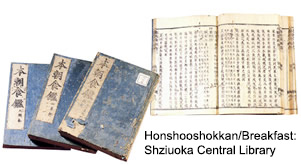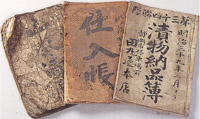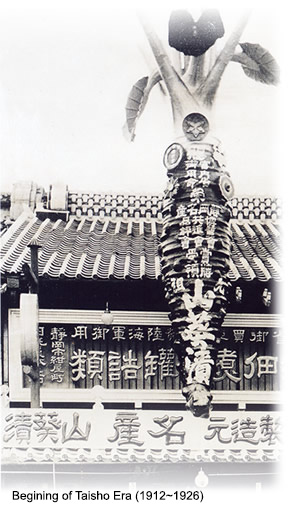

Wasabi preserves are said to be first manufactured between 1751 and 1763. In the wasabi birthplace along the Abe River the wasabi stems (leaf stems) were preserved in home-made miso made with rice bran to accompany family meals. Merchants conducting miso and soy sauce business in that area came up with various manners to make wasabi preserves especially coming with the idea to mix chopped wasabi with sake white lees. That was then that such preserves started to be sold under the name of “Wasabi Zuke”.
The name of Tamaruya Honten came to be known all over Japan in 1889. It was just after the main Tokaido Railway Line came into service. Opening a preserves company in Hontoori in Shizuoka City first generation owner Mochizuki Torakichi took note of the steam power at the vanguard of civilization, and after many trials and errors acquired the right to open a wasabi preserves shop inside the Shizuoka Station premises. Next, ceasing to sell wasabi preserves on a chariot he came up with a new business idea by filling a round cosmetic barrel made in Sawara to peddle his products to travelers through the train windows.
This unique “barrel filled wasabi preserves” gained great popularity with travelers and helped spread the the name of “Shizuoka Famous Products Tamaruya Wasabi Preserves” all over the nation. The next momentous stage occurred 100 later. Surmounting the Shizuoka Great Fire and the destructions of the war Tamaruya Wasabi Preserves grew into celebrated national top brand for its taste and quality. In our so-called “one hundred million gourmets era” it achieved the adjective of “true deliciousness” and helped the popularity of the Japanese flavorful piquancy of “wasabi”. Such popularity promises a constant widening need of wasabi preserves for the future.

The cultivation of edible wasabi was is said to have started between 1596 and 1615 in Suruga (presently Shizuoka City), more precisely in the village of Utogi along the upper stream of the Abe River. The villagers of Utogi used to collect wasabi on one side of a valley whose slope was called Wasabi Yama. They then attempted to replant and grow in wells fed by spring waters. The results surpassed expectations and the villagers then switched to cultivation in small water fields filled with river waters.
In the background during the Muromachi Era (1392~1573), wasabi was consumed in cold soups by common people. Although wasabi has then been found to marry well with seafood, it is thought it was only part of simple meals then.
One hundred years after it was recorded that wasabi had been successfully grown in Utogi, two large floods in 1702 destroyed all the wasabi fields and 4 homes out of 28 were completely washed away. At the time it is thought that wasabi fields were organized into fruitful cultivation.


















